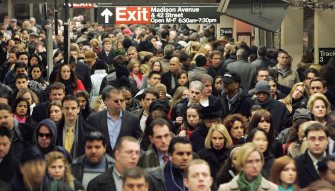How Living in Big Inner Cities Makes People Healthier and Happier

It’s strange, this desire we show for neatly packaged stories. Our brains love easy narratives. We like our folklore quickly digestible. Take the agriculture myth: humans were hunter-gatherers, someone figured out farming, the world began planting. End of story.
That story is way more complex, as James C Scott argues in his fascinating new survey of the formation of the earliest states, Against the Grain. Sedentism didn’t just happen; societies rebelled against the formation of cities. The transition to an agrarian state didn’t take one generation, but 160 of them—4,000 years in total.
“Clearly our ancestors did not rush headlong into the Neolithic revolution or into the arms of the earliest states,” writes Scott.
Interestingly, common history states that agriculture happened, then people started clustering together. Yet there is evidence that sedentism began occurring before farms were in place. Widespread food distribution networks—and the tax revenue they supplied—might have taken millennia, but humans forming cities is old indeed. Humans have long known that crowding into small spaces and working together is to our benefit.

Commuters pass through Grand Central Terminal during morning rush hour in New York City. (Mario Tama/Getty Images)
Which is what recent research published in The Lancet argues. Recognizing the global pervasiveness of obesity and diseases too much sedentism promotes, such as cardiovascular disease and type 2 diabetes, the study’s authors claim that living in areas with tight social networks fosters physical activity and emotional bonds. As co-author Chinmoy Sarkar told Reuters,
“As cities get more and more compact, they become more walkable. In denser residential areas, they are better designed and more attractive destinations. We are less dependent on our cars and use public transport more.”
This research comes in the wake of prime minister Theresa May’s announcement that the British government is lending $2.6 billion for the construction of 25,000 rental homes in the social housing sector. This is on top of another $13.2 billion that will help new homeowners secure property by lowering deposit requirements.
For the paper’s authors, Sarkar and Chris Webster, time and space are relevant issues. Lower population densities, they argue in a paper from January, means less specialized services, fewer chances for social interactions, less populated city centers, and longer travel times for health care services (specifically, emergency services). Of course, infectious diseases are more likely to spread in densely packed neighborhoods, though the authors believe quicker access to health care makes it a worthwhile tradeoff.
We often treat disease like early cities, as if a clear-cut story explains the process: you get sick, you need medicine, you get better. Only disease does not work like that either. In fact, one of the number one indicators that your immune system will resist disease is your social support network. Humans are no islands floating through a world of infectious agents. We are an interconnected species inextricably linked to our environment. The more we populate our environment with others, the healthier we are.
This does not mean a city is automatically utopia, however. The authors point out that design is crucial:
“Health status and risk originates from complex interactions between an individual’s inherent physiology and genetics interacting with contextual socio-economic, built and natural environmental variables.”
The built environment (BE) must promote active living, which includes plenty of green areas, spaces for walking and cycling, and make access to public transportation and designated walking regions easy to reach. Being able to socially interact is critical, so designing such meeting places is mandatory. Spaces for natural healing, such as parks and hiking trails, reduces physiological and psychological stress. Reducing noise and air pollution is a must. And facilitating nutritious food companies while limiting junk food providers is also paramount to the success of a healthy city.

Patrons sit before a free concert in Central Park by the New York Philharmonic in New York City. (Mario Tama/Getty Images)
Such models are hard to imagine in a free market like America, especially given its growing insistence on less governmental intervention. While a city like Los Angeles, where I live, is booming with fresh, natural food choices, we are also experiencing a housing crisis for both homeless and low income residents as well as middle class citizens, plus a dearth of immediate green spaces.
The authors do consider supply-side economics next to public health initiatives. While admitting regulations are sometimes necessary, they point to high taxes on cigarettes and alcohol as effective means for promoting healthier lifestyles, wondering if that can translate into city planning. Such a translation is difficult to imagine in some cities, however. The median home price in my neighborhood of Palms is $939,800, well beyond the means of most Angelenos. The health of cities, in some ways, is like the health of individuals: good for those who can afford it.
Which doesn’t escape the authors. Having spent decades in city planning, they conclude with their own questions. Does one giant park or several smaller ones make more sense? What is the proper balance of public zones and private real estate? How are different age demographics best served from neighborhood to neighborhood? How do you best separate industry, a necessary component of a city, with residential regions?
Sarkar is optimistic that well informed data presented to local governments will be a no-brainer:
“With evidence, we can plan multi-functional, attractive neighborhoods that promote physical activity, promote social interaction, and shield from negatives such as pollution and feeling unsafe.”
Their questions above, among many others, will define city planning in the decades to come. One thing the authors are certain of is that cities are better for the health of humans. How to honor that fact remains to be seen.
—
Derek is the author of Whole Motion: Training Your Brain and Body For Optimal Health. Based in Los Angeles, he is working on a new book about spiritual consumerism. Stay in touch on Facebook and Twitter.





